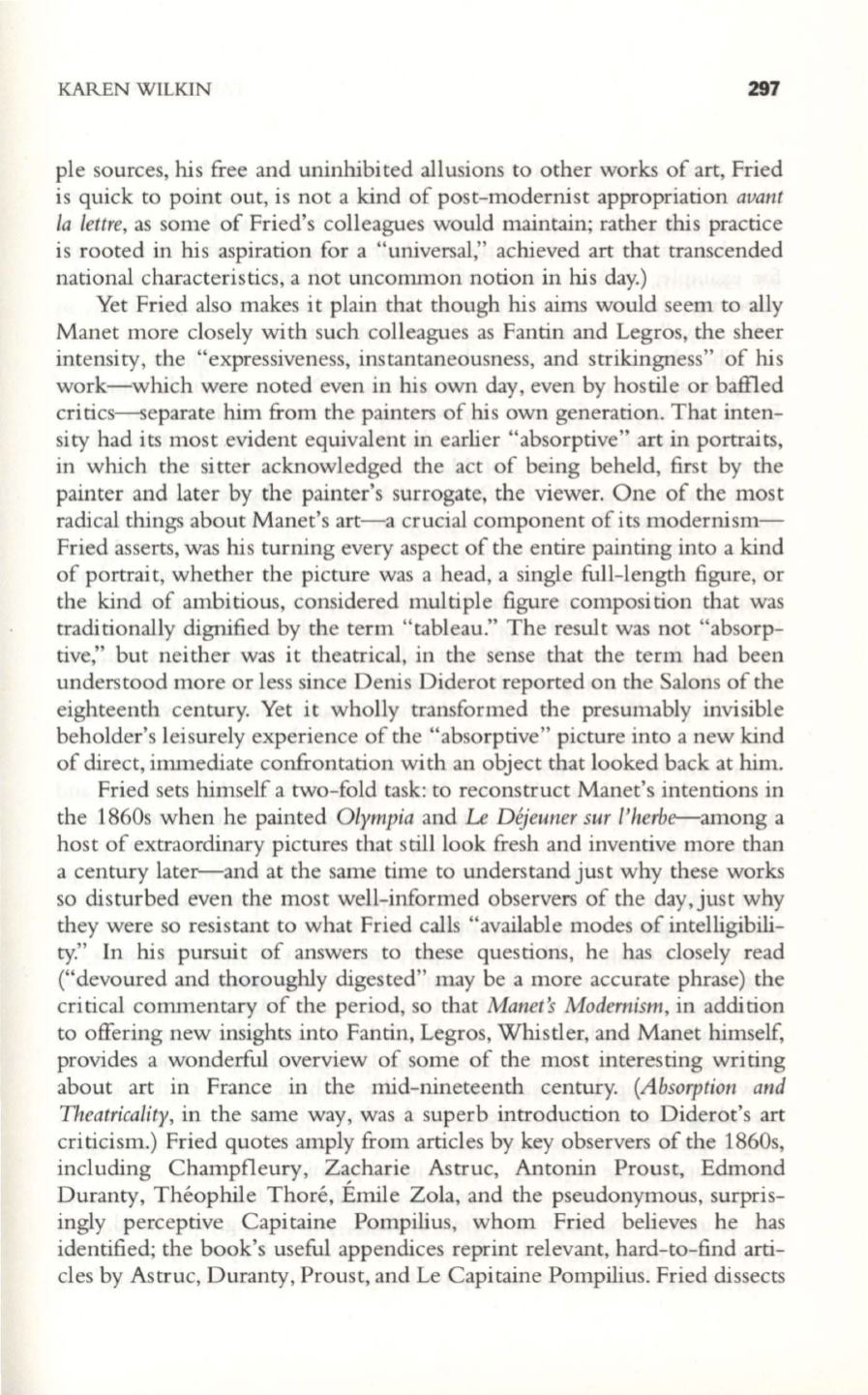
KAREN WILKIN
297
pIe sources, his free and uninhibited allusions to other works of art, Fried
is quick to point out, is not a kind of post-modernist appropriation
avant
la lettre,
as some of Fried's colleagues would maintain; rather this practice
is rooted in his aspiration for a "universal," achieved art that transcended
national characteristics, a not uncommon notion in his day.)
Yet Fried also makes it plain that though his aims would seem to ally
Manet more closely with such colleagues as Fantin and Legros, the sheer
intensity, the "expressiveness, instantaneousness, and strikingness" of his
work-which were noted even in his own day, even by hostile or baffied
critics-separate
him
from the painters of his own generation. That inten–
sity had its most evident equivalent in earlier "absorptive" art
in
portraits,
in which the sitter acknowledged the act of being beheld, first by the
painter and later by the painter's surrogate, the viewer. One of the most
radical things about Manet's art-a crucial component of its modernism–
Fried asserts, was his turning every aspect of the entire painting into a kind
of portrait, whether the picture was a head, a single full-length figure, or
the kind of ambitious, considered multiple figure composition that was
traditionally dignified by the term "tableau." The result was not "absorp–
tive," but neither was it theatrical, in the sense that the term had been
understood more or less since Denis Diderot reported on the Salons of the
eighteenth century. Yet it wholly transformed the presumably invisible
beholder's leisurely experience of the "absorptive" picture into a new kind
of direct, immediate confrontation with an object that looked back at him.
Fried sets himself a two-fold task: to reconstruct Manet's intentions in
the 1860s when he painted
Olympia
and
Le
Dejeuner sur l'herbe--among
a
host of extraordinary pictures that still look fresh and inventive more than
a century later-and at the same time to understand just why these works
so disturbed even the most well-informed observers of the day, just why
they were so resistant to what Fried calls "available modes of intelligibili–
ty." In his pursuit of answers to these questions, he has closely read
("devoured and thoroughly digested" may be a more accurate phrase) the
critical commentary of the period, so that
Manet's Modernism,
in addition
to offering new insights into Fantin, Legros, Whistler, and Manet himself,
provides a wonderful overview of some of the most interesting writing
about art in France in the mid-nineteenth century.
(Absorption and
Theatricality,
in the same way, was a superb introduction to Diderot's art
criticism.) Fried quotes amply from articles by key observers of the 1860s,
including Champfleury, Zacharie Astruc, Antonin Proust, Edmond
Duranty, Theophile Thore, Emile Zola, and the pseudonymous, surpris–
ingly perceptive Capitaine Pompilius, whom Fried believes he has
identified; the book's useful appendices reprint relevant, hard-to-find arti–
cles by Astruc, Duranty, Proust, and Le Capitaine Pompilius. Fried dissects


